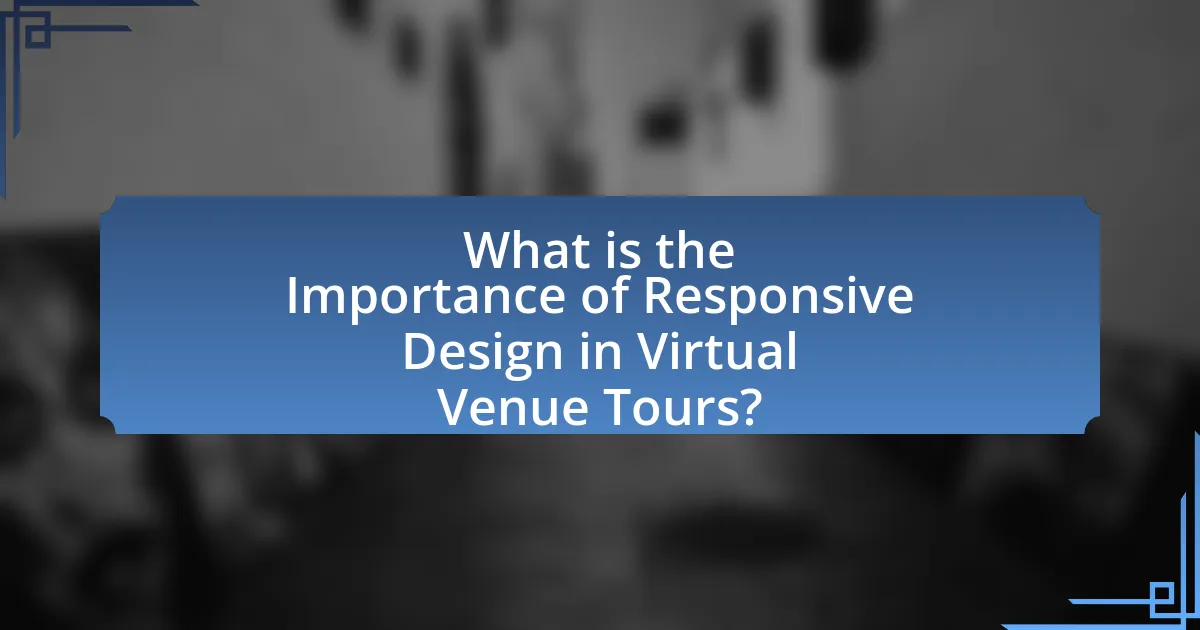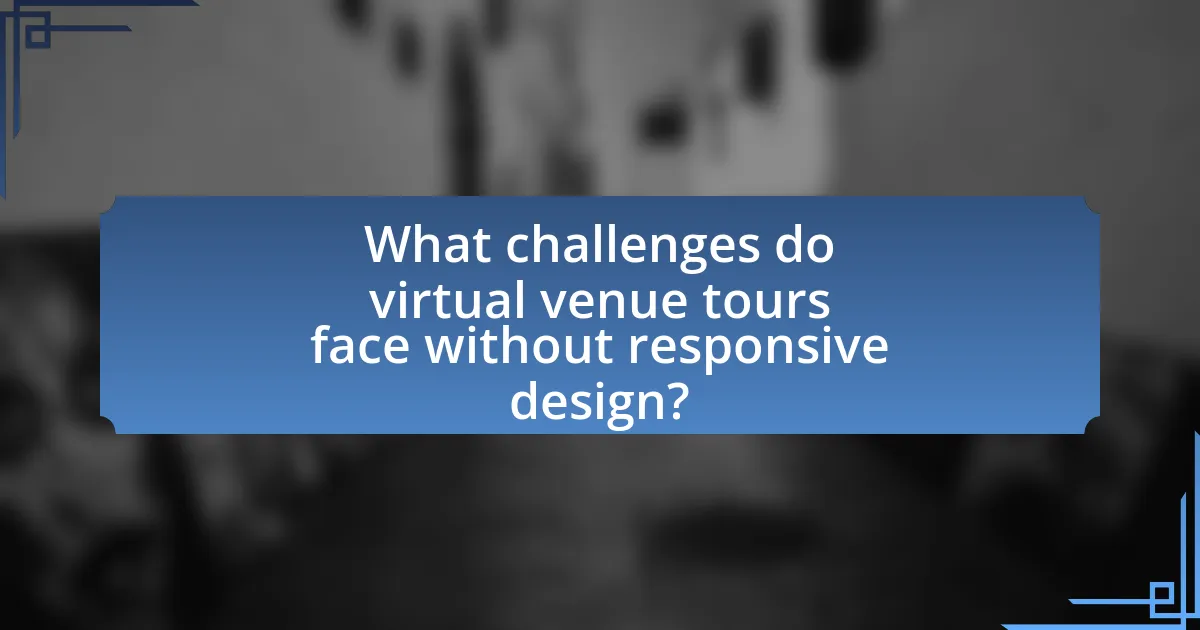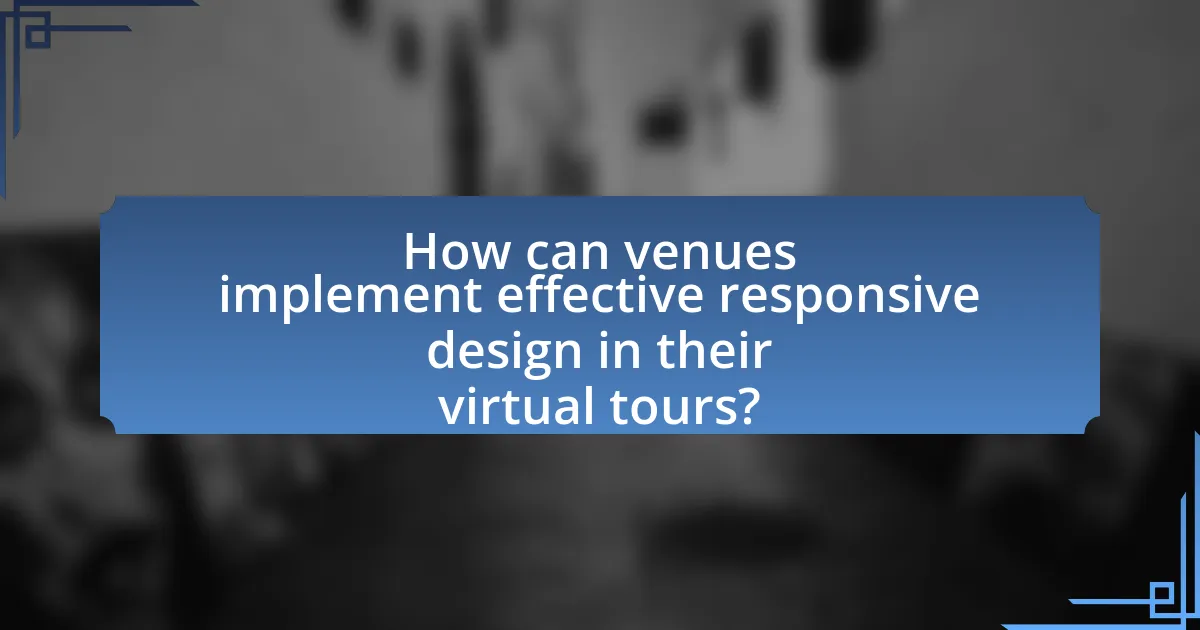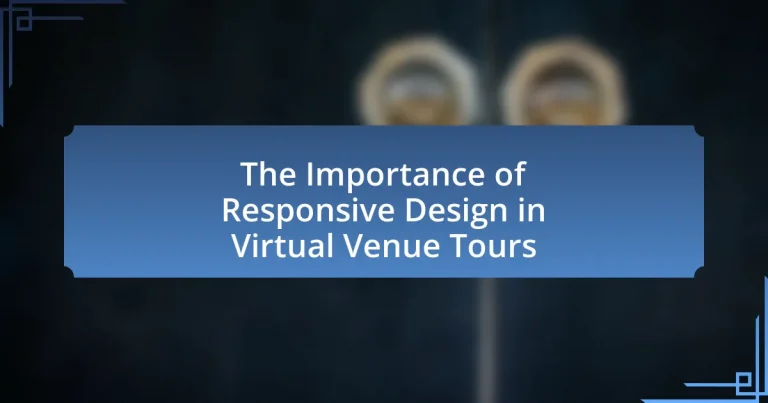Responsive design is a critical aspect of virtual venue tours, ensuring optimal user experience across various devices such as smartphones, tablets, and desktops. This article explores the significance of responsive design in enhancing user engagement, accessibility, and retention rates, emphasizing the necessity for fluid grids, flexible images, and media queries. It also addresses the challenges faced by virtual tours lacking responsive design, including poor user experience and negative brand perception. Furthermore, the article outlines best practices for implementing effective responsive design and highlights future trends and innovations that can further enhance virtual venue tours.

What is the Importance of Responsive Design in Virtual Venue Tours?
Responsive design is crucial in virtual venue tours because it ensures that users have an optimal viewing experience across various devices, including smartphones, tablets, and desktops. This adaptability enhances user engagement and accessibility, allowing potential clients to explore venues seamlessly regardless of their device. According to a study by Google, 61% of users are unlikely to return to a mobile site they had trouble accessing, highlighting the necessity of responsive design in retaining user interest and satisfaction.
How does responsive design enhance user experience in virtual venue tours?
Responsive design enhances user experience in virtual venue tours by ensuring that the interface adapts seamlessly to various devices and screen sizes. This adaptability allows users to access the tour on smartphones, tablets, and desktops without compromising functionality or visual quality. Research indicates that 57% of users will not recommend a business with a poorly designed mobile site, highlighting the critical role of responsive design in retaining user engagement. By providing a consistent and intuitive experience across devices, responsive design significantly improves user satisfaction and increases the likelihood of users exploring the venue further.
What are the key elements of responsive design in this context?
The key elements of responsive design in the context of virtual venue tours include fluid grids, flexible images, and media queries. Fluid grids allow the layout to adapt to various screen sizes by using relative units instead of fixed units, ensuring that content scales appropriately. Flexible images automatically resize within their containing elements, maintaining visual integrity across devices. Media queries enable the application of different styles based on device characteristics, such as screen width, enhancing user experience. These elements collectively ensure that virtual venue tours are accessible and visually appealing on any device, which is crucial for engaging users effectively.
How does responsive design affect accessibility for users?
Responsive design enhances accessibility for users by ensuring that websites adapt seamlessly to various devices and screen sizes. This adaptability allows individuals with disabilities, such as those using screen readers or requiring larger text, to navigate content more easily. According to the Web Content Accessibility Guidelines (WCAG), responsive design principles support accessibility by providing a consistent user experience across devices, which is crucial for users with different needs. Furthermore, a study by the Nielsen Norman Group found that users with disabilities benefit significantly from responsive layouts, as they reduce the need for excessive scrolling and zooming, thereby improving overall usability.
Why is responsive design crucial for engagement in virtual venue tours?
Responsive design is crucial for engagement in virtual venue tours because it ensures that users have an optimal viewing experience across various devices, such as smartphones, tablets, and desktops. This adaptability increases user satisfaction and retention, as studies show that 57% of users will not recommend a business with a poorly designed mobile site. Furthermore, responsive design enhances accessibility, allowing a broader audience to explore virtual venues seamlessly, which can lead to higher conversion rates and increased interest in the venue.
How does responsive design impact user retention rates?
Responsive design significantly enhances user retention rates by ensuring a seamless experience across various devices. When users access virtual venue tours on mobile, tablet, or desktop, a responsive design adapts the layout and content to fit their screen size, which improves usability and satisfaction. Research indicates that 57% of users will not recommend a business with a poorly designed mobile site, highlighting the direct correlation between responsive design and user retention. Furthermore, a study by Google found that 61% of users are unlikely to return to a mobile site they had trouble accessing, underscoring the importance of responsive design in keeping users engaged and encouraging repeat visits.
What role does responsive design play in user interaction during tours?
Responsive design significantly enhances user interaction during tours by ensuring that content is accessible and visually appealing across various devices. This adaptability allows users to engage with virtual tours seamlessly, whether on smartphones, tablets, or desktops. Research indicates that 57% of users will abandon a site if it takes longer than three seconds to load, highlighting the necessity of responsive design for maintaining user interest and engagement. By optimizing layouts, images, and navigation for different screen sizes, responsive design fosters a more immersive and user-friendly experience, ultimately leading to higher satisfaction and retention rates during virtual tours.

What challenges do virtual venue tours face without responsive design?
Virtual venue tours face significant challenges without responsive design, primarily including accessibility issues and poor user experience across devices. Without responsive design, users accessing the tours on mobile devices may encounter distorted images, navigation difficulties, and slow loading times, leading to frustration and potential abandonment of the tour. Research indicates that 57% of users will not recommend a business with a poorly designed mobile site, highlighting the importance of a seamless experience. Additionally, lack of responsiveness can limit the reach of virtual tours, as mobile users represent a substantial portion of internet traffic, with Statista reporting that mobile devices accounted for over 50% of global web traffic in 2021. Thus, the absence of responsive design directly impacts user engagement and satisfaction in virtual venue tours.
How can poor design affect user satisfaction in virtual tours?
Poor design significantly diminishes user satisfaction in virtual tours by creating a frustrating and confusing experience. When users encounter issues such as slow loading times, unclear navigation, or unresponsive interfaces, their ability to engage with the content is compromised. Research indicates that 47% of users expect a webpage to load in two seconds or less, and 40% will abandon a site that takes more than three seconds to load. This impatience translates directly to virtual tours, where poor design can lead to increased bounce rates and negative perceptions of the venue. Additionally, a lack of intuitive design can result in users feeling lost or overwhelmed, further detracting from their overall experience and satisfaction.
What specific issues arise from non-responsive designs?
Non-responsive designs lead to several specific issues, primarily affecting user experience and accessibility. Users accessing a non-responsive site on various devices, such as smartphones or tablets, encounter layout problems, including distorted images, overlapping text, and navigation difficulties. According to a study by Google, 61% of users are unlikely to return to a mobile site they had trouble accessing, highlighting the importance of responsive design for retaining visitors. Additionally, non-responsive designs can negatively impact search engine rankings, as Google prioritizes mobile-friendly sites in its algorithms. This can result in decreased visibility and traffic, further exacerbating the challenges faced by businesses relying on virtual venue tours.
How do these issues influence the overall perception of the venue?
Issues related to responsive design in virtual venue tours significantly influence the overall perception of the venue by affecting user experience and accessibility. When a virtual tour is not optimized for various devices, users may encounter difficulties navigating the content, leading to frustration and a negative impression of the venue. Research indicates that 57% of users will not recommend a business with a poorly designed mobile site, highlighting the importance of seamless access across platforms. Consequently, venues that prioritize responsive design are perceived as more professional and user-friendly, enhancing their reputation and attracting more visitors.
What are the consequences of neglecting responsive design in virtual venue tours?
Neglecting responsive design in virtual venue tours leads to a poor user experience across devices, resulting in decreased engagement and potential loss of customers. When virtual tours are not optimized for various screen sizes, users may struggle to navigate, view content, or interact with features, which can lead to frustration and abandonment of the tour. Research indicates that 57% of users will not recommend a business with a poorly designed mobile site, highlighting the importance of responsive design in retaining user interest and satisfaction. Additionally, search engines prioritize mobile-friendly sites, meaning that neglecting responsive design can negatively impact search rankings and visibility, further diminishing the potential audience for virtual venue tours.
How does it affect the venue’s brand image?
Responsive design in virtual venue tours positively affects the venue’s brand image by enhancing user experience and accessibility. When a venue implements responsive design, it ensures that potential clients can easily navigate and engage with the virtual tour on any device, which reflects a commitment to modernity and customer satisfaction. Research indicates that 57% of users will not recommend a business with a poorly designed mobile site, highlighting the importance of responsive design in maintaining a favorable brand perception. Consequently, venues that prioritize responsive design are likely to attract more visitors and foster a positive reputation in a competitive market.
What financial implications can arise from a lack of responsive design?
A lack of responsive design can lead to significant financial implications, including decreased conversion rates and increased bounce rates. When websites are not optimized for various devices, users experience frustration, which can result in abandoning the site; studies show that 57% of users will not recommend a business with a poorly designed mobile site. Additionally, businesses may face higher customer acquisition costs due to ineffective user experiences, as potential customers are less likely to engage with a non-responsive site. This can ultimately lead to lost revenue opportunities, as companies miss out on sales from mobile users, who accounted for over 50% of global web traffic in 2021.

How can venues implement effective responsive design in their virtual tours?
Venues can implement effective responsive design in their virtual tours by utilizing flexible layouts, scalable images, and adaptive navigation that adjusts to various screen sizes and devices. This approach ensures that users have an optimal viewing experience, regardless of whether they access the tour on a desktop, tablet, or smartphone. For instance, using CSS media queries allows venues to tailor the presentation of content based on the device’s characteristics, enhancing usability and engagement. Additionally, incorporating touch-friendly elements and ensuring fast loading times are critical, as studies show that 53% of mobile users abandon sites that take longer than three seconds to load. By prioritizing these design principles, venues can significantly improve user satisfaction and accessibility in their virtual tours.
What best practices should venues follow for responsive design?
Venues should follow several best practices for responsive design to ensure optimal user experience across devices. First, they must implement a fluid grid layout that adapts to various screen sizes, allowing content to resize proportionally. Additionally, venues should utilize flexible images that scale within their containing elements, preventing distortion and ensuring clarity on all devices.
Moreover, employing media queries is essential; these allow for the application of different styles based on device characteristics, such as screen width and resolution. This practice enhances usability by tailoring the interface to the user’s device.
Furthermore, venues should prioritize mobile-first design, which involves designing for smaller screens before scaling up to larger displays. This approach aligns with the increasing trend of mobile internet usage, which, according to Statista, accounted for over 54% of global website traffic in 2021.
Lastly, testing across multiple devices and browsers is crucial to identify and rectify any issues that may arise, ensuring a seamless experience for all users. By adhering to these best practices, venues can effectively enhance their virtual tours and overall online presence.
How can venues ensure compatibility across different devices?
Venues can ensure compatibility across different devices by implementing responsive design principles that adapt content to various screen sizes and resolutions. Responsive design utilizes flexible grids, layouts, and media queries to provide an optimal viewing experience on smartphones, tablets, and desktops. According to a study by Google, 61% of users are unlikely to return to a mobile site they had trouble accessing, highlighting the necessity for venues to prioritize device compatibility to enhance user engagement and satisfaction.
What tools and technologies can assist in creating responsive designs?
Tools and technologies that assist in creating responsive designs include CSS frameworks like Bootstrap and Foundation, which provide pre-designed components and grid systems for fluid layouts. Additionally, media queries in CSS allow developers to apply different styles based on device characteristics, ensuring optimal viewing experiences across various screen sizes. JavaScript libraries such as jQuery can enhance interactivity and responsiveness, while design tools like Adobe XD and Figma facilitate the creation of responsive prototypes. These tools are widely adopted in the industry, with Bootstrap being used by over 18% of all websites as of 2023, demonstrating their effectiveness in responsive design implementation.
What common mistakes should be avoided in responsive design for virtual tours?
Common mistakes to avoid in responsive design for virtual tours include neglecting mobile optimization, failing to test across various devices, and using fixed layouts. Mobile optimization is crucial as over 50% of users access content via mobile devices, and a lack of it can lead to poor user experience. Not testing across different devices can result in inconsistencies in how the tour is displayed, which can frustrate users. Additionally, using fixed layouts limits flexibility and can cause content to be cut off or misaligned on smaller screens. These mistakes can significantly hinder user engagement and satisfaction.
How can venues identify and rectify these mistakes?
Venues can identify and rectify mistakes in their virtual tours by conducting user experience testing and analyzing user feedback. User experience testing involves observing how real users interact with the virtual tour, allowing venues to pinpoint areas of confusion or frustration. Additionally, gathering feedback through surveys or direct communication can highlight specific issues users encounter, such as navigation difficulties or visual inconsistencies.
To rectify these mistakes, venues should implement changes based on the insights gained from testing and feedback. For instance, if users struggle with mobile navigation, venues can optimize the design for smaller screens, ensuring that all interactive elements are easily accessible. Regularly updating the virtual tour based on ongoing user feedback can further enhance the experience, leading to improved engagement and satisfaction.
What impact do these mistakes have on user experience?
Mistakes in responsive design significantly degrade user experience by causing frustration and confusion. When users encounter issues such as improper scaling, navigation difficulties, or slow loading times, they are likely to abandon the virtual venue tour. Research indicates that 53% of mobile users will leave a page that takes longer than three seconds to load, highlighting the critical nature of performance in user retention. Additionally, inconsistent layouts across devices can lead to misinterpretation of content, further diminishing user engagement. Therefore, these design mistakes directly impact user satisfaction and the overall effectiveness of virtual venue tours.
What are the future trends in responsive design for virtual venue tours?
Future trends in responsive design for virtual venue tours include enhanced interactivity, integration of augmented reality (AR), and improved accessibility features. Enhanced interactivity allows users to engage with the virtual environment through real-time feedback and customizable experiences, making tours more immersive. The integration of AR will enable users to overlay digital information onto the physical space, enriching the tour experience. Improved accessibility features will ensure that virtual tours cater to a wider audience, including those with disabilities, by incorporating voice navigation and screen reader compatibility. These trends are supported by the increasing demand for user-centric design and the growing adoption of AR technologies in various sectors.
How is technology evolving to support responsive design?
Technology is evolving to support responsive design through advancements in CSS frameworks, flexible grid systems, and media queries. These developments enable designers to create layouts that adapt seamlessly to various screen sizes and orientations. For instance, frameworks like Bootstrap and Foundation provide pre-built responsive components that streamline the design process. Additionally, the use of media queries allows for specific styling adjustments based on device characteristics, ensuring optimal user experiences across platforms. According to a 2022 report by Statista, over 50% of global web traffic now comes from mobile devices, highlighting the necessity for responsive design in modern web development.
What innovations can enhance virtual venue tours in the coming years?
Innovations that can enhance virtual venue tours in the coming years include the integration of augmented reality (AR) and virtual reality (VR) technologies, which provide immersive experiences. AR can overlay digital information onto the physical environment, allowing users to interact with venue features in real-time, while VR can create fully immersive environments that simulate the venue experience. According to a report by Statista, the AR and VR market is projected to reach $209.2 billion by 2022, indicating a significant investment in these technologies. Additionally, advancements in 360-degree video and interactive storytelling can further engage users, making virtual tours more dynamic and informative. These innovations not only improve user engagement but also enhance the overall accessibility of venue tours, catering to a wider audience.
What practical tips can venues apply to improve responsive design in their tours?
Venues can improve responsive design in their tours by implementing mobile-first design principles, ensuring that all content is easily accessible and visually appealing on various devices. This approach prioritizes the user experience on smartphones and tablets, which account for over 50% of web traffic according to Statista. Additionally, venues should utilize flexible grid layouts that adapt to different screen sizes, ensuring that images and text scale appropriately. Incorporating touch-friendly navigation elements enhances usability on mobile devices, as studies show that users prefer interfaces that are easy to interact with on smaller screens. Regularly testing the tours on multiple devices and browsers can identify potential issues, allowing venues to make necessary adjustments for optimal performance.


